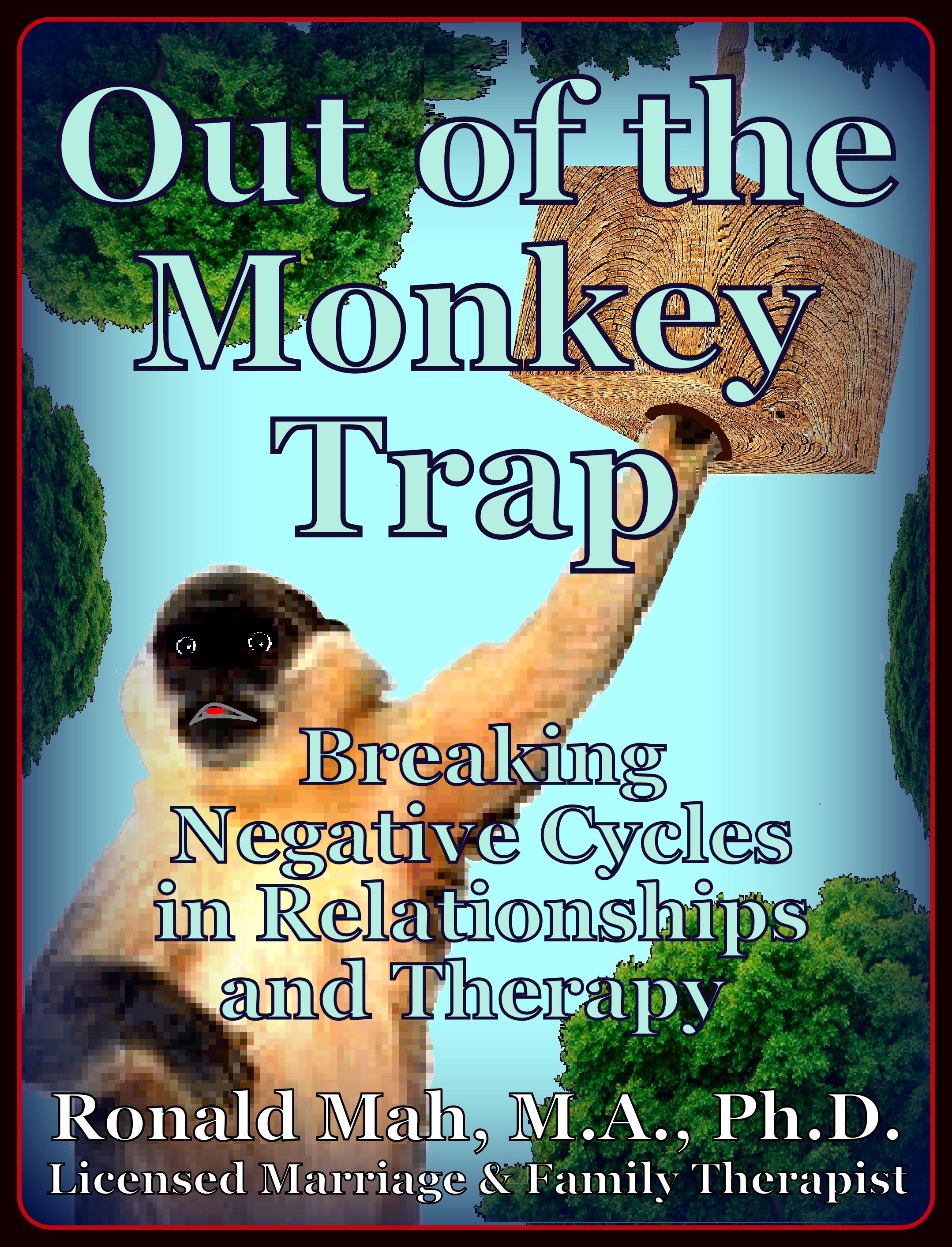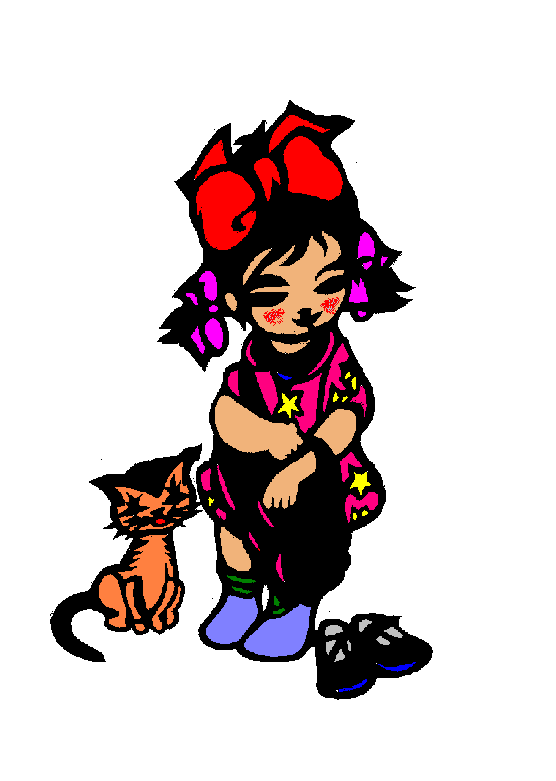21. Crisis Impasse 2nd Order Change - RonaldMah
Ronald Mah, M.A., Ph.D.

Licensed Marriage & Family Therapist,
Consultant/Trainer/Author
Main menu:
21. Crisis Impasse 2nd Order Change
Therapist Resources > Therapy Books > Out Monkey Trap- Breaking Cycles Rel

Out of the Monkey Trap, Breaking Negative Cycles for Relationships and Therapy
Chapter 21: CRISIS & IMPASSE AND SECOND ORDER CHANGE
by Ronald Mah

Since second order change requires a person to step outside what is familiar and comfortable, it normally is the consequence of significant pressure on the system. In these discussions, the system is that of the relationship. It is "characterized by decline and crisis, repetitive failing efforts to correct the situation by first order changes, chaos, efforts to go 'back to basics,' demise, discontinuity, reframing, a sudden shift in perception, insight, illumination, a discovery or creation of a new vision, and a jump to a higher order (Levy, 1986, page 13). Ordinary and ongoing dilemmas and problems for a relationship are often tolerated because they do not cross a threshold of pain or despair. Many individuals accept odd personal peccadilloes as part of the package deal included with the positive compelling traits of their partners or family members. Unexpected, unpleasant, and incomprehensible behaviors or habits are worth living with as long as they are not somehow violating of core needs and values. However, minor issues as they may symbolize fundamental betrayal, abandonment, or rejection create crises of the relationship viability and of individual psychic, emotional, or spiritual survival. The initial reaction of an individual to a threat to self or the relationship is to somehow find a way to assimilate the behavior or communication into his or her existing existential structure. It can be perceived as first order change to make it fit cognitively and otherwise to the person's sense of self and how the world should be. "If a discrepancy emerges, however, between ongoing reality and existing cognitive structures, this state of affairs- in Piagetian terms- leads to a 'moment of disequilibrium,' or cognitive (and emotional) conflict. Under normal developmental conditions, the cognitive system resolves the conflict either by assimilating enough knowledge to reestablish equilibrium or by accommodating the structure. Accommodation, a second-order process, represents a proactive or developmental change in cognitive structures. If accommodation is successful, equilibrium is then pursued at a higher or more complex developmental level (Piaget, 1981)" (Lyddon, 1990, page 123).
It should be noted that second order processing, as does accommodation requires more advanced developmental maturity that an individual, one or both partners, or all family members may not possess. The emotionally reactive process that often characterizes problematic relationship dynamics may be a result of a person's inability to accommodate cognitively and behaviorally to a new demand. Individuals often anticipate the relationship functioning as a holding environment to satisfy adult attachment needs. As a place of safety and security, the intimate relationship is a sanctuary from the stresses and unpredictability of the greater world. There is an expectation and an experience of equilibrium. Equilibrium is achieved and kept through a dynamic process of first order processes. Although there are demands and stresses on the system from the outside, first order change allows it to adapt as needed to remain essentially the same. When excessive stress crosses a threshold of tolerance, however, the system and existing relationships will often break down. "This 'symmetry breaking,' in turn, leads to additional fluctuations and eventual reorganization of the system. Referred to as dissipative change, this type of change represents a nonlinear transformation in system structures and involves a qualitative reformulation of the system and its capacities (second-order change). An important feature of dissipative change is that such change is often preceded by system jolts, turbulent environmental stresses, or internal conflicts, all of which serve as catalysts for the marked transformation that occurs (cf. Caple, 1985; Ford, 1987; Guidano, 1987; Sinnott, 1989) (Lyddon, 1990, page 123).
Dissipative structure theory suggests that many dynamic living systems, from small systems to larger global systems do not evolve in a regular smooth process. Development occurs instead through ongoing processes of organization, disorganization, and reorganization. From a developmental perspective, change occurs through the interplay of quantitative change and qualitative change. Smaller and simpler quantitative changes accumulate over time- a form of first order change. Eventually, quantitative changes reach a critical mass that disrupts the first order stability and thrusts the organism, person, or system into qualitative change, which is second order change. Levy (1986) described the four developmental stages of second-order change:
1. Decline. External and internal needs are not appropriately met. Warning signals about the need for radical reorganization are denied or avoided. Efforts to cope with problems by first-order change result in crisis, chaos, procrastination, efforts to go "back to basics," resistance to change, and anger. Through ever-increasing fluctuation, the system reaches a critical point beyond which the alternative is demise or revitalization.2. Transformation. This stage includes acceptance of the need for change, discontinuity from the past, commitment to change, reframing processes, creating or discovering new realities, a sudden shift in perception, a moment of illumination, insight, and the emergence of a new direction quantitatively and qualitatively different from the old one. This stage also involves a departure from the old beliefs and habits, the process of "letting go."3. Transition. This stage includes planned and managed efforts to translate ideas and visions into action steps, programs, structures, and procedures. The focus is on assessing solutions and their impact and managing the transition from an unstable state to a new stable state.4. Stabilization and development occurs when the change program is institutionalized, tuned up, maintained, and developed by first order changes. In this study the focus was on the "transformation stage" from both theoretical and practical perspectives. (page 13-14).
Levy also breaks down each of the stages in "The Cycle of Second-Order Change." (page 14).
Decline crisis:
DenialAvoidanceResistanceProcrastinationTriggering event
Transformation:
AwarenessAcceptanceLetting goReframingCommitment
Transition:
PlanningTrainingManagingTransitioningImplementing
Development:
StabilizingTune-upDevelopment
The therapist can use the stages and cycle of second order change for guidance in working with the individual, couple, or family. In the initial interview, the therapist may be able to recognize stages in the individual, couple, or family's process. The individual, couple, or family will have already been through their own version of the first two stages of decline and transformation. The relationship quality and satisfaction has declined. External and internal needs have not been appropriately met. Over months or years, individuals have ignored warning signals that they need to do something very different. Previous attempts to alter or heal the relationship by first order change have not worked. They have denied the erosion of the relationship, avoided pain, resisted change, and procrastinated about trying something really different such as therapy. Things have worsened with resultant "crisis, chaos, procrastination, efforts to go 'back to basics,' resistance to change, and anger." As the relationship kept on fluctuating through negative times and experiences, they reached "a critical point beyond which the alternative is demise or revitalization." Finally there may have been a triggering event that brought them into a crisis state. Separation or divorce has become a possibility where it had never been considered previously. The individual, couple, or family goes through a transformation before deciding to come to therapy. Instead of experiencing ongoing problems as something to work through and something that will be successfully worked through, individuals became aware that they must try to change, stop repeating previous dynamics, take a new look at what they have been doing, and find "a sudden shift in perception, a moment of illumination, insight, and the emergence of a new direction quantitatively and qualitatively different from the old one." The individual, couple, or family accepted that the old ways have not, are not, and will not work. They realized that they needed to let go some rigidly held beliefs and behaviors. The behaviors got reframed as obstacles rather than as facilitating intimacy. Deciding to try therapy was a commitment to the relationship and to finding a way to make it work. The therapist reviewed the first two developmental stages of getting to second order change with the individual, couple, or family. The therapist may take the individuals into deeper process within these two stages. For example, in the first session the Genevieve and Dillard confess that they fight too much. As such, there is an implicit if not explicit request for the therapist to help them not fight as much. If the therapist went along the request, he or she would respond with a first order change suggestion to further resist fighting with each other. Instead, the therapist said, "It's not that you fight too much. It's that you fight really lousy! You avoid fighting… both had been taught in childhood to avoid fighting, so that now you really don't know how to fight well."
First order change would have sought fewer fights, less intense fights, and fights that didn't last as long. Genevieve and Dillard had already unsuccessfully been trying to do that. They saw fighting as attempts to win that destroyed the partner's self-esteem. The second order change intervention reframed fighting as an essential relationship process that Genevieve and Dillard needed to embrace rather than avoid… to practice rather than resist. It also redefined fighting rather than as a destructive relationship dynamic, as an essential relationship skill to achieve greater intimacy. As and if the therapist is able to facilitate second order conceptualization of fighting, then second order change can follow in the stage of transition- the third stage. In this part of therapy, Genevieve and Dillard with the therapist plans and manages efforts to "translate ideas and visions into action steps, programs, structures, and procedures. The focus is on assessing solutions and their impact and managing the transition from an unstable state to a new stable state." The therapist may train the couple how to communicate differently as they confront conflict issues. This may be accompanied with homework assignments to implement new approaches and skills to practice fighting at home. The therapist may have the couple revisit an old fight and have them work at fighting well, that is fight or argue with an emphasis on understanding one another. Genevieve and Dillard will transition from conflict avoidance to conflict acceptance, from clumsy fighting to skillful fighting, and from disconnection to intimacy. The fight would focus on intimacy as a second order change goal rather than the previous first order goals of winning and destroying the partner. With more practice and developing skills, the previous negative fluctuations would hopefully stabilize to healthier dynamics.
When Genevieve and Dillard has conceptually shifted and can own second order change, the therapist moves to the fourth stage of stabilization and development. The new behaviors and inter-relational processes need to become habitual for the couple. The adaptations prompted by second order change become "institutionalized, tuned up, maintained, and developed by first order changes. The new normal in this situation is regular "fights" between the Genevieve and Dillard to check in and clarify expectations and meanings of behaviors. Conflict is now seen as productive and foundational for intimacy, rather than a failure of intimacy. Confrontation rather than avoidance becomes first order change solutions. Genevieve and Dillard would continue to apply and re-apply these first order changes to maintain the new equilibrium. Occasionally, the couple may need to revisit what they have learned. They may possibly return to work with the therapist again to get a tune up if they have veered off course. They would continue to reapply and develop nuances and variations of the new model's strategies and behaviors until some possible future point where they do not work. At that point, it may be time to engage in second order change again. Genevieve and Dillard may be able to recognize the need for second order change, or more remain likely to fall into a crisis or get stuck in an impasse once again.

